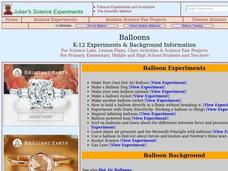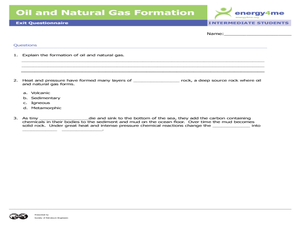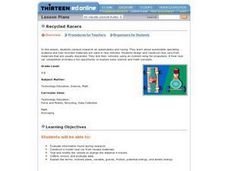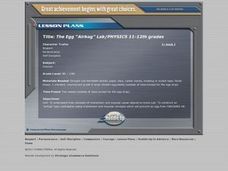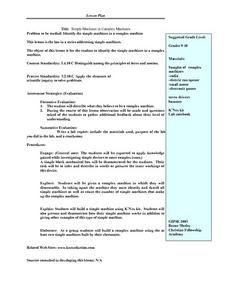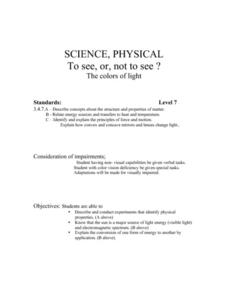Curated OER
Race the Track! Jump the Gap
Students record data of using a track system with variables and how those variables affect a ball used in the track. In this track lesson plan, students design their own track in groups, test the ball's rates of speed, and record their...
Curated OER
Balloons
Students explore the different types of balloons. In this materials lesson students can complete several experiments including building their own hot air balloons, making balloon animals and experimenting with static...
Curated OER
Plate Tectonics
Learners identify that most of mountain ranges found on all major land masses and in the oceans are external reflections of tectonic movements within the earth. They identify that earthquakes and related phenomena are caused by the...
Curated OER
Eratosthenes And Radius of the Earth
Students calculate the radius of the earth. They use the method and data suggested by Eratosthenes. They investigate the interrelationships among mass, distance, force, and time through experimental processes.
Curated OER
Oil and Natural Gas Formation
Students complete a narrative paper and a drawing depicting how the formation of oil and natural gas taken from the Earth's crust were once plants and animals millions of years ago. In this oil and natural gas lesson plan, students read,...
Curated OER
Recycled Racers
Students research automobile operating systems in relation to racing. They design and construct vehicles from recycled material which they race to study the concept of propulsion.
Curated OER
Wind Tunnels
Students build a simple wind tunnel and test out 2 glider wing shapes at different angles of attack. They record results and their observations just as engineers do.
Curated OER
Exploring the Interstellar Medium
Students investigate the Interstellar Medium and the Local Bubble that the Sun is inside. They read and discuss a handout, answer discussion questions, observe a demonstration of light scattering, and conduct an experiment on the...
Curated OER
What is Sound? How Can We Change Sound?
In this instructional activity, students investigate the phenomenon of sound! Students compare and contrast how sound travels through solids, liquids, and gases. They explain how length and thickness affect sound. Students know the...
Curated OER
Magnets
Students investigate the magnetic attraction of different materials by observing a demonstration, and review the words "attraction" and "materials." Next they conduct exploration of a number of materials which have different properties...
Curated OER
How Do The Colors of Light Mix?
Students investigate the mixing of light. They form a hypotheses to reason why color changes occur and they write conclusions and ask new questions arising from the investigation. Students identify the primary and complementary colors of...
Curated OER
The Egg "Airbag" Lab
Students use what they know about momentum and impulse to construct an effective "air bag" to protect an egg dropped from the top of the football stadium or other tall structure. They complete a final written report of their findings.
Curated OER
Reflections
Students are given materials with various textures and light sources to investigate specular reflection, diffuse, reflection, angle of incidence, and angle of reflection. Students draw and label an everyday scenario showing specular and...
Curated OER
Snow Day
Eighth graders work in small groups to design and build a snow remover while looking at a snow design brief. They combine 2 or more simple machines to form a compound machine following the design brief in order to meet the required...
Curated OER
Simple Machines In Complex Machines
Pupils brainstorm the concept of a machine. They make lists of the characteristics that all machines share. The teacher uses questioning in order to get students to think more deeply about the subject. They create a lab to demonstrate...
Curated OER
To See or Not to See: The Colors of Light
Seventh graders describe and conduct an experiment that identifies the physical properties of light. They explore sources of visible light and an electromagnetic spectrum. Students explain the conversion of one form of energy to another.
Curated OER
Parachutes
Students control the parachutes using arm movements. They follow directions while participating in games. Students explore the effects of wind on several objects. They study the effects of shape, size and weight on a parachute.
Curated OER
Secrets of Lost Empires II -- Roman Bath
Students build an arch with no mortar following the design of the Romans. They use cookies to represent the blocks used and work to distribute the weight on the stones.
Curated OER
Habits of Mind
Students study tree leaves to complete the activity, For this tree leaf experiment lesson, students observe, measure, and sort tree leaves individually, in groups, and in relationship to the entire tree.
Curated OER
Designing a Solar Concentrator
Students design and build a solar concentrator. In this physics instructional activity, students evaluate their design and convince everyone why theirs is the best. They create a presentation and share it with the class.
Curated OER
Height of Bounce
Eighth graders determine the relationship between the height of bounce of a ping-pong ball and the height from which it was dropped. They are assessed on the ability to record and interpret data, graph data, make predictions, and make...
Curated OER
Pendulum
Sixth graders are instructed on how to create a pendulum and measure the periodicity of the pendulum, using four different combinations of string. They are asked which influences the time more- the length of the string or the weight at...
Curated OER
Electrical Energy
Students conduct an experiment to find out how well different wires radiate heat when voltage is applied across the wire. They use the results of their experiments to consider how the gauge of the wire and the type of wire affect the...
Curated OER
Machines at Work
Students discuss how simple machines have made our lives easier and construct a compound machine. For this machines lesson plan, students watch a video on machines, look at websites, and follow task cards in order to make a simple machine.

